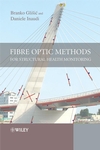I have contributed a chapter on "Structural health monitoring of bridges: general issues and applications"
Structural health monitoring is an extremely important methodology in evaluating the ‘health’ of a structure by assessing the level of deterioration and remaining service life of civil infrastructure systems. This book reviews key developments in research, technologies and applications in this area of civil engineering. It discusses ways of obtaining and analysing data, sensor technologies and methods of sensing changes in structural performance characteristics. It also discusses data transmission and the application of both individual technologies and entire systems to bridges and buildings.
With its distinguished editors and international team of contributors, Structural health monitoring of civil infrastructure systems is a valuable reference for students in civil and structural engineering programs as well as those studying sensors, data analysis and transmission at universities. It will also be an important source for practicing civil engineers and designers, engineers and researchers developing sensors, network systems and methods of data transmission and analysis, policy makers, inspectors and those responsible for the safety and service life of civil infrastructure.
Structural health monitoring: applications and data analysis
F N Catbas, University of Central Florida, USA
PART 1 STRUCTURAL HEALTH MONITORING TECHNOLOGIES
Piezoelectric impedence transducers for structural health monitoring of civil infrastructure systems, Y W Yang and C K Soh, Nanyang Technological University, Singapore
Wireless sensors and networks for structural health monitoring of civil infrastructure systems, R A Swartz and J P Lynch, University of Michigan, USA
Synthetic aperture radar and remote sensing technologies for structural health monitoring of civil infrastructure systems, M Shinozuka, University of California, USA and B Mansouri, International Institute of Earthquake Engineering and Seismology, Iran
Magnetoelastic stress sensors for structural health monitoring of civil infrastructure systems
M L Wang, Northeastern University, USA
Vibration-based damage detection techniques for structural health monitoring of civil infrastructure systems, V M Karbhari, University of Alabama in Huntsville and L S-W Lee, University of the Pacific, USA
Operational modal analysis for vibration-based structural health monitoring of civil structures, V M Karbhari, University of Alabama in Huntsville, H Guan HDR, USA and C Sikorsky, California Department of Transportation, USA
Fiber optic sensors for structural health monitoring of civil infrastructure systems, F Ansari, University of Illinois at Chicago, USA
Data management and signal processing for structural health monitoring of civil infrastructure systems, D K McNeill, University of Manitoba, Canada
Statistical pattern recognition and damage detection in structural health monitoring of civil infrastructure and other systems, K Worden, G Manson and S Rippengill, University of Sheffield, UK
PART 2 APPLICATIONS OF STRUCTURAL HEALTH MONITORING IN CIVIL INFRASTRUCTURE SYSTEMS
Structural health monitoring of bridges: general issues and applications, D Inaudi, SMARTEC SA, Switzerland
Structural health monitoring of cable-supported bridges in Hong Kong, K Y Wong, Highways Department and Y Q Ni, The Hong Kong Polytechnic University, Hong Kong
Structural health monitoring of historic buildings, A De Stefano, Turin Polytechnic and P Clemente, ENEA, Italy
Structural health monitoring research in Europe: trends and applications, W R Habel, BAM Federal Institute for Materials Research and Testing, Germany
Structural health monitoring research in China: trends and applications, J Ou, Dalian University of Technology and Harbin Institute of Technology and H Li, Harbin Institute of Technology, China
 Prof. Branko Glisic and his team have recently installed a SHM system on the Streicker Bridge at Princeton University.
Prof. Branko Glisic and his team have recently installed a SHM system on the Streicker Bridge at Princeton University.



.JPG)






.jpg)













